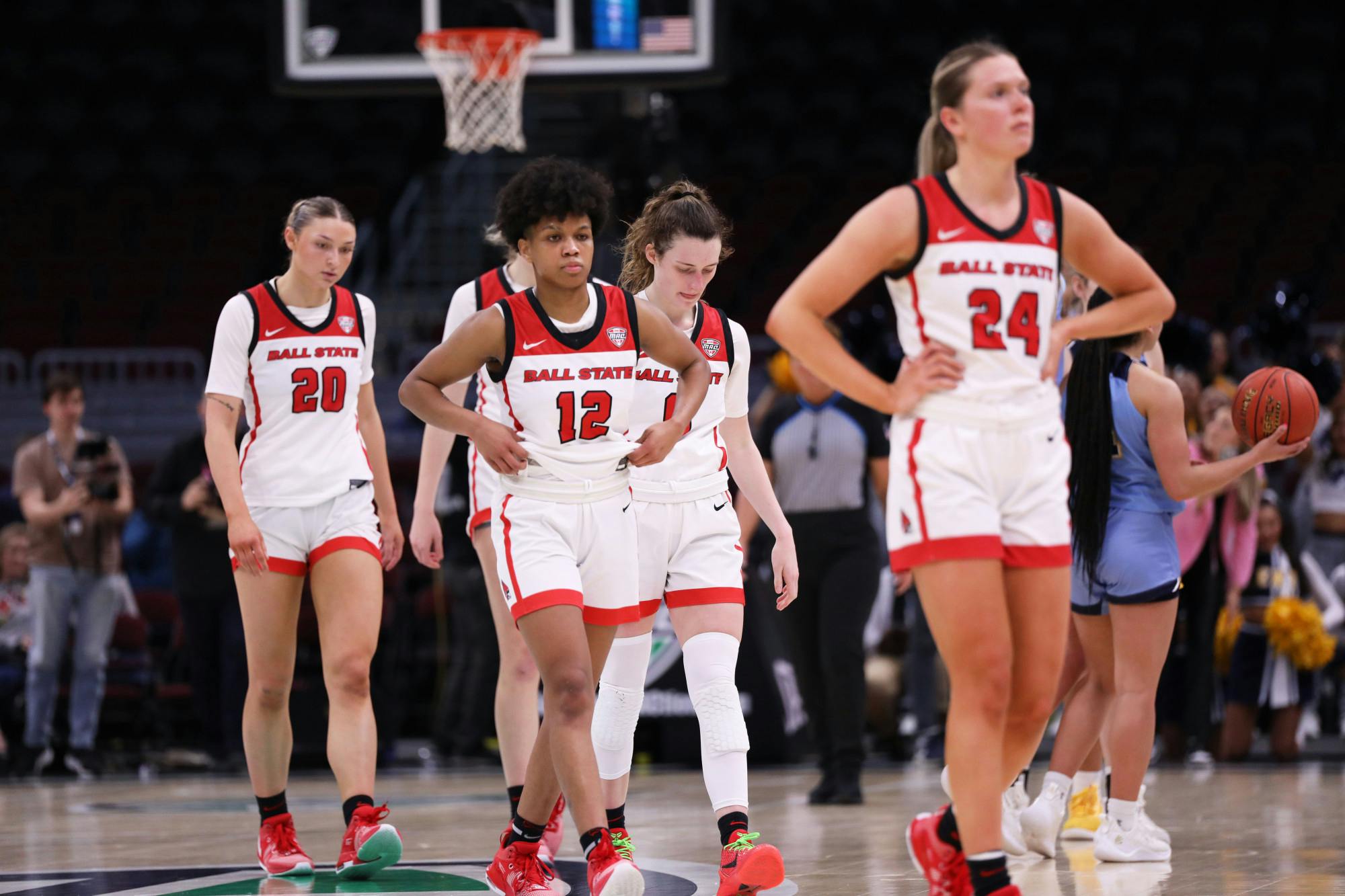28-5? Doesn’t matter. Ball State women’s basketball left out of NCAA Tournament

Watching the Selection Sunday program, I knew Ball State women’s basketball’s name was not going to be called.
I covered the 28-5 Cardinals all season. The record shows a team of success. A 14-game win streak, two wins against Power 5 schools, three games on national television and games against top-ranked UConn and Notre Dame.
Regardless, as the Cardinals fell to Kent State in Cleveland in the Mid-American Conference (MAC) Tournament semifinals 65 to 50, one of the first thoughts in my mind was, “I can’t believe I won’t see this team in the NCAA Tournament.”
A loss to Toledo (26-5), Kent State (MAC Champion), Northern Illinois, ranked UConn (Big East Champion) and ranked Notre Dame (ACC Champion). That is it.
Head coach Brady Sallee said the selection committee is not the problem, it is the parameters around them. Frankly, I agree with him.
“The problem is what the head of women’s basketball in the NCAA has put forth in what they want out of this thing [the tournament],” Sallee said. “If the question is if Toledo is an NCAA team or is Ball State an NCAA team? Of course [they both are].”
The real problem is the NET rankings for women’s basketball. The system used is complicated and differs from the men’s system. Sit tight.
NET rankings include two factors. First, Adjusted Net Efficiency, which actually has three components according to the NCAA website.
- Efficiency = offense efficiency (points/possessions) – defensive efficiency (opponent points/possessions).
- Strength of opponents played.
- Location of the game, so home, away and neutral.
What?
Second, it accounts for the team value index. Know what this is? Neither do I. Here is what the NCAA says about it.
“Team Value Index (TVI), which is a result-based feature that rewards teams for beating quality opponents, particularly away from home, as well as an adjusted net efficiency rating. The adjusted efficiency is a team’s net efficiency, adjusted for strength of opponent and location (home/away/neutral) across all games played. For example, a given efficiency value (net points per 100 possessions) against stronger opposition rates higher than the same efficiency against lesser opponents and having a certain efficiency on the road rates higher than the same efficiency at home.”
Essentially it factors the winner, where the game is played and the opponent.
This is the men’s quadrant system that is used to judge the quality of wins in the season, directly from the NCAA website explaining NET rankings in those quadrants.
- Quadrant 1: Home 1-30, Neutral 1-50, Away 1-75
- Quadrant 2: Home 31-75, Neutral 51-100, Away 76-135
- Quadrant 3: Home 76-160, Neutral 101-200, Away 135-240
- Quadrant 4: Home 161-353, Neutral 201-353, Away 241-353
The rankings on what seed or number you are in quadrants are not the same as women. Instead, it uses models for women’s data and men use men’s data. Weights for each also use historical data, according to the NCAA.
The website also states that a Quad 1 win means more for NCAA Tournament selection than a Quad 3 or Quad 4 win.

Ball State women’s basketball walks to the locker after their loss to Kent State March 15 at Rocket Mortgage FieldHouse in Cleveland, Ohio. The Cardinals lost in the semi-final round of the Mid-American Conference tournament. Mya Cataline, DN
This is a cut, dry and simple system that is easily mapped out and charted through the course of the season. KenPom and voting rankings like the Associated Press (AP), USA Today and more are also important in March.
“The fact we do not have quads screams agenda,” Sallee said. “It makes no sense.”
The Cardinals finished with the best offense in the MAC, putting up 2413 points (73.1 average and No. 38 in the nation). Ball State had the second-best defense, only allowing an average of 60.5 points per game. They also had the second-highest margin of victory, being teams on average by 12.7 points (ranked No. 38 in the nation).
Even with double-digit losses in four out of their five losses, Ball State still had their win margin in double-digits.
The Cardinals have a top-50 bench in the nation. They are ranked No. 45 with an average of 22.8 bench points per game. They are ranked No. 49 in the nation on an assist-to-turnover ratio of 1.11. They are ranked No. 46 in the nation with assists per game being at 15.8. They are ranked No. 43 in the nation on field goal percentage with 44.56 percent. They are No. 18 with a turnover margin of 5.21. I could go on, to see more stats, check out this link. Not to mention, No. 17 in winning percentage with 84 percent.
Junior Nyla Hampton is ranked No. 31 in the nation with her assist-to-turnover ratio of 2.28, she is also ranked No. 35 with her 162 assists. Hampton is also fourth in the nation with 109. Junior Ally Becki joins her on the assist list at No. 39 with 160 assists. Junior Madelyn Bischoff sits ranked No. 49 in the country with her 38 percent shooting from 3-point range.
All these stats line up to show a top-50 team in the nation. Ball State is a team that should be in the tournament without a shadow of a doubt. They competed all year and the numbers do not lie. Regardless, they are ranked No. 77 in the NET rankings. HOW!
Sallee said the whole NET ranking system favors the Power 5 conferences in the tournament. It is easy to see why with a team like Michigan.
Michigan plays Big Ten competition in the regular season. Big Ten teams have higher NET rankings with great teams leading the league, meaning they will, as a result, have a higher ranking due to the strength of their schedule.
Toledo beat Michigan 69-46 Dec. 6, 2023. Michigan finished 9-9 in the Big Ten and is a 9 seed in the NCAA Tournament.
“Everybody in the SEC and ACC count those wins and say, ‘We were 8-8 in the ACC,”” Sallee said. “They do not go through and say ‘Well, we are really 4-6 against the good teams.’ They just say “We are in it [NCAA Tournament] and everyone says ‘Yeah, you are right.’
“We are all the sheep [because they] are in the ACC. Step back and think about it for a second.”
Even though Sallee was referring to Ball State’s wins over the University of Pittsburgh (ACC) and the University of Georgia (SEC), the same follows for a team in the Big Ten, just another Power 5 conference.
A 26-5 Toledo team beat the breaks off of Michigan, but they are left out of the NCAA Tournament due to their NET rankings being lower. But that 9-9 Michigan team will have the opportunity to fight for a national championship on the national stage.
People can come up with an excuse like, “Well you have to play a better non-conference schedule,” but what a lot of people do not realize is that both teams have to schedule it and accept it.
With only 13 non-conference games, Ball State played four Power 5 schools. The effort was there to play bigger opponents to try and reach the NCAA committee, but in the end, the committee looked at a Mid-Major regular season and dismissed the credibility due to NET rankings.
“We just have a system that is no good,” Sallee said.
So teams like Texas A&M (19-10 6-10 SEC) an 11 seed, Arizona (17-15, 8-10 PAC12) an 11 seed, and Maryland (19-13, 9-9 Big Ten) a 10 seed are in the NCAA Tournament this year. Yet again, another year of the NCAA rewarding the Power 5 schools for mediocracy. A 28-5 Ball State team will likely head to the Women’s National Invitational Tournament (WNIT). Nothing wrong with the WNIT, but it is not where a team with five losses should be spending their March.
Contact Elijah Poe via email at elijah.poe@bsu.edu or on X @ElijahPoe4.

